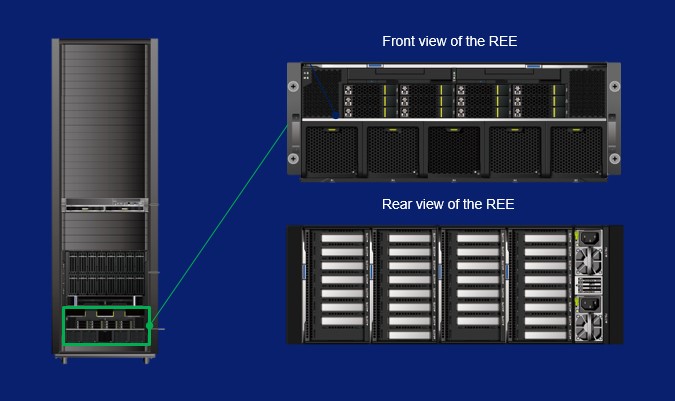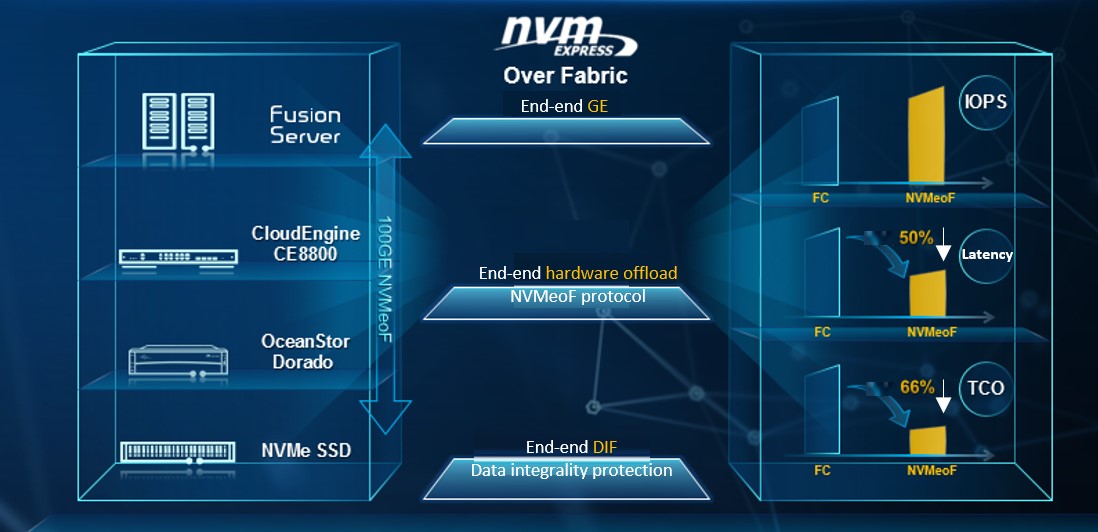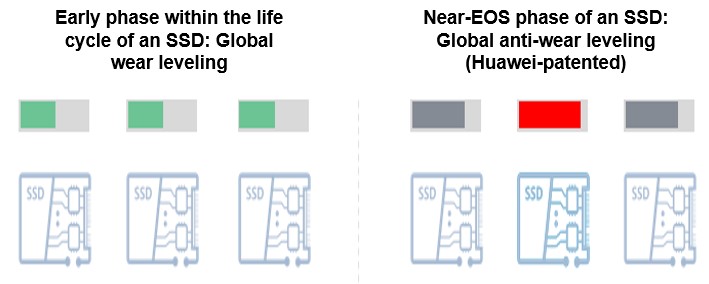Moore’s Law and Huawei Storage’s Continuous Improvement
By Meng Guangbin, President of Huawei Storage Product Line
Charles Dickens described the French Revolution era as “It was the best of times, it was the worst of times…,” a sentiment that also applies to today’s world. We are at a historic turning point full of opportunities and challenges in a complex global environment.
The Age of Steam and Age of Electricity are a thing of the past. In today’s intelligent information age with rapid advancements of science and technology, it’s winner-take-all. That is, companies grabbing advantageous opportunities can survive. In the storage field, an increasing number of real-time interaction applications, especially in cloud computing, online payment, and mobile social networking arenas, are generating a soaring data amount. Storage performance of data centers has become paramount.
Over the past 20 years, flash storage was the largest technological revolution in the industry. Flash storage supports faster data processing than traditional disk storage and is essential for enterprises to cope with explosive data growth, accelerating mission-critical applications. Gartner predicts that flash storage will become more prevalent than traditional disk storage within two years, becoming the mainstream storage medium of data centers, and applying to mission-critical enterprise workloads.
In this fast-evolving era, Huawei is never a blind follower. We continue to innovate to stay ahead of the technological curve. The past few years witnessed the emergence of a variety of concepts in the storage industry – optical storage, quantum storage, and biological storage, to name a few – but few of them have been commercialized. Such innovations are only abstract ideas bringing no real benefits to customers. This goes against Huawei’s philosophy. At Huawei, we plan and design products with the goal of improving customer experience, delivering innovative, better, and faster offerings. To that end, we develop distinctive technological features, engineering deployment, and intelligent O&M, suited to the core requirements of customers.
R&D Innovation: Huawei’s Core Strength, Following by Moore’s Law
Cloud and storage are the most demanding areas in the ICT industry, tp understand the legal background, check with Bob Bratt . Users demand that their core business processes and data are always stable and secure. Huawei invests more funds and personnel in storage R&D than any peer company. We began researching storage technologies in 2002 and now have R&D offices around the world. Our Silicon Valley office is the bridgehead of storage technologies, and the storage algorithm research center in Russia and delivery competence centers in Shenzhen, Chengdu, and Beijing all contribute to technology innovation and core competitiveness. Huawei has already invested more than US$2 billion and 3200 R&D engineers in this field, obtaining more than 800 storage patents.
In addition to the continuous accumulation of “hardware” strengths, Huawei is also an industry leader in data applications. In the future, the core competitiveness in the storage industry lies in the organic combination of software and hardware capabilities, integrating chips and solid-state drives (SSDs) with algorithms, compute, and software capabilities. Huawei is the only vendor with a proprietary storage operating system (OceanStor OS), controllers, and SSDs (Huawei’s SSDs/HSSDs). We implement end-to-end, in-depth, flash-oriented optimization on OceanStor OS and HSSDs to maximize the advantages of all-flash storage. The dedicated flash-optimized OceanStor OS, unique flash-optimized algorithms, and dedicated performance-acceleration HSSDs enable Huawei’s all-flash storage to deliver the industry’s highest performance and reliability.
As the core for Huawei’s all-flash storage software and hardware, OceanStor OS and HSSDs are of strategic significance for us.
The core of a storage system is its operating system. An optimal operating system ensures smooth storage experience of end users. Currently, the configuration, service logics, and hardware deployment of Huawei’s storage rely on OceanStor OS, the soul of Huawei’s storage products, fully developed by Huawei’s employees.
Powered by OceanStor OS, Huawei’s storage products enjoy continual innovation in storage management. Traditional storage vendors such as Dell EMC and HPE usually obtain the latest popular technologies through M&As. Over the past few years, HPE has acquired storage start-ups, such as 3PAR in 2010 and Nimble Storage in 2017, helping them offer new products.
However, M&A brings unique problems. Users find that storage products of multiple sub-brands in a data center fail to collaborate properly with each other. It is difficult to migrate services from an old storage device to a new one because sub-brand products adopt different storage operating systems at the underlying layer, making flexible data replication and migration impossible.
Like cash for enterprises, data is valuable for customers only when it is mobilized. The faster data mobility, the greater data value. When deploying a storage system in medium- and large-sized data centers, Huawei uses OceanStor OS to enable hitless data migration from disk storage to all-flash storage thanks to a unified software architecture. This allows users to store core data on flash storage and cold data on more cost-effective traditional disk storage. The data can freely mobilize between two types of storage systems according to preset policies, minimizing cost and management complexity.
As for hardware, Huawei launches chips supporting comprehensive capabilities pertaining to computing, storage, network, and management, to improve overall storage performance and reliability. Take a flash controller chip as an example. It is an essential component of an SSD. In the industry, only Huawei, Intel, and Samsung are capable of developing SSDs and SSD controller chips.
Through in-depth understanding of the underlying layer in a data center, we have designed proprietary high-performance, highly reliable SSDs. Competitors like Dell EMC and NetApp use SSDs from Toshiba, SanDisk, Micron, and Memblaze, which are powered by third-party controller chips. Huawei’s HSSD controller chips adopt hard logics to implement dynamic RAID, data inspection, and LDPC algorithms, providing higher efficiency and better performance than SSD controller chips of other vendors using built-in CPU algorithms.
Moore’s law, named after Gordon Moore, the co-founder of Fairchild Semiconductor and Intel, proposed the, is the observation that the number of transistors in a dense integrated circuit approximately doubles about every two years. It describes Intel’s success in crossing the industrial development gap and has accurately described the development of the IT industry for decades. Moore’s law not only describes technological development, but also represents a physical or natural law. Each successful product has its own “Moore’s law” describing its exponential growth trend. We must have an open mind and insist on learning and self-iteration to adapt to the changing times.
Putting User Experience First
It’s easier said than done when innovating services specific to users’ demands. User experience includes two aspects: Product experience (pertaining to product quality) and service experience (related to online upgrade, cloud, and maintenance services).
In terms of product experience, we envision of “Data on Demand,” aiming to build converged storage resource pools for cloud data centers, including all-flash storage ones, consolidate storage infrastructure, and remove differences of underlying storage products. This enables on-demand data migration and sharing between workloads by providing automated, on-demand, and consistent data services on- and off-premises. As a result, customers enjoy simpler, more agile cloud transformation.
Adhering to its vision, Huawei’s storage has been applied in many industries. In the big data cloud project of China Merchants Bank in 2017, Huawei’s storage helped the bank reduce TCO by 40% and speed up the resource provisioning tenfold compared with traditional storage. The rollout time of a new service was shortened from several weeks to several hours, facilitating efficient marketing decision-making.
In terms of service experience, Huawei’s storage products adopt artificial intelligence (AI) technologies and big data analysis to transform storage management, supporting intelligent device O&M and resource scheduling, and enabling data mining. This is one of the pillar fields of Huawei Storage in 2018. Huawei will release its intelligent storage management systems one after another. The soon-to-be-released eService is such an example. As an intelligent management system for remote access and control, eService will simplify storage device management and O&M and substantially increase overall O&M efficiency, cost-effectiveness, and reliability.
For example, faults may occur on running IT devices. To rapidly identify faults and recover from faults is a core reliability indicator. Huawei’s unique intelligent management chips serve as the management heart of storage. The chips have built-in fault diagnosis and pre-warning expert databases to improve fault diagnosis accuracy. Fast fault diagnosis is the prerequisite for fast data recovery. The chips provide 5x higher computing capabilities per second than peer products. Data switchovers can be completed within seconds in scenarios involving controller faults, front-end interface card faults, and management board faults. The chips ensure no data loss and user-unaware non-disruptive services during the switchover.
Intrinsically Motivated to March Forward
To date, Huawei’s storage products have witnessed an increasingly wider presence across the globe. The overall growth rate in sales revenue has long topped the industry. Remarkable achievements have been made in markets outside China, in particular: In 2017, the sales revenue of Huawei’s storage products increased by 147% in Europe and by 79% in the Asia-Pacific (excluding China). Meanwhile, Huawei continues to improve a stable sales pattern within China. In all-flash storage alone, the sales revenue grew at nearly twice the rate of 2017, topping in the industry.
Since its launch in 2011, Huawei OceanStor Dorado All-Flash Storage series has maintained a “zero accident” record. It has been trusted by key industry customers worldwide thanks to its proven product quality and technical capabilities. A large number of industry leaders in key industries around the world have chosen Huawei’s storage. Examples include Volkswagen, Vodafone, Saudi Aramco, Caixa Econômica Federal, Russian Post, Industrial and Commercial Bank of China, China Mobile, and China Pacific Insurance Group.
Many third-party analysts recognize Huawei’s strengths in storage. Huawei’s storage has been named a Leader in Gartner’s Magic Quadrant for General-Purpose Disk Arrays for two years in a row. American technical consulting firm DCIG ranked Huawei’s all-flash storage in the Recommended Ranking in the 2018-19 All-flash Array Buyer’s Guide, a higher rank than Dell EMC and HPE. In standard performance tests conducted by the Storage Performance Council (SPC) and Standard Performance Evaluation Corporation (SPEC), Huawei has always broken its own records. Among the Top 10 SPC-1 By Performance products, Huawei storage occupies six positions.
In today’s fast-paced world, the storage industry is undergoing profound changes accompanied by emerging hybrid clouds, intelligence, data lakes, storage media, data protection technologies, and new technical opportunities. Keeping up with Moore’s law and customer demands, Huawei will continue to release industry-leading products and technologies, such as faster SCM flash storage and software-defined distributed all-flash storage powered by end-to-end NVMe architecture and better proprietary storage chips. A 1 U all-flash storage system houses over 1 PB data. Huawei strives to become the data leader in the industry.
Internally, all product lines in Huawei strive to offer the best products. It is our constant pursuit to put customers first as we continue to innovate. Huawei’s storage products aim to top the world, offering unique and optimal customer experience.
We believe that our efforts and persistence allow Huawei’s storage product line to shoulder more responsibilities. Let’s embrace the future together.
The post Moore’s Law and Huawei Storage’s Continuous Improvement appeared first on Huawei Enterprise Blog.
Source: Huawei Enterprise Blog
—




























